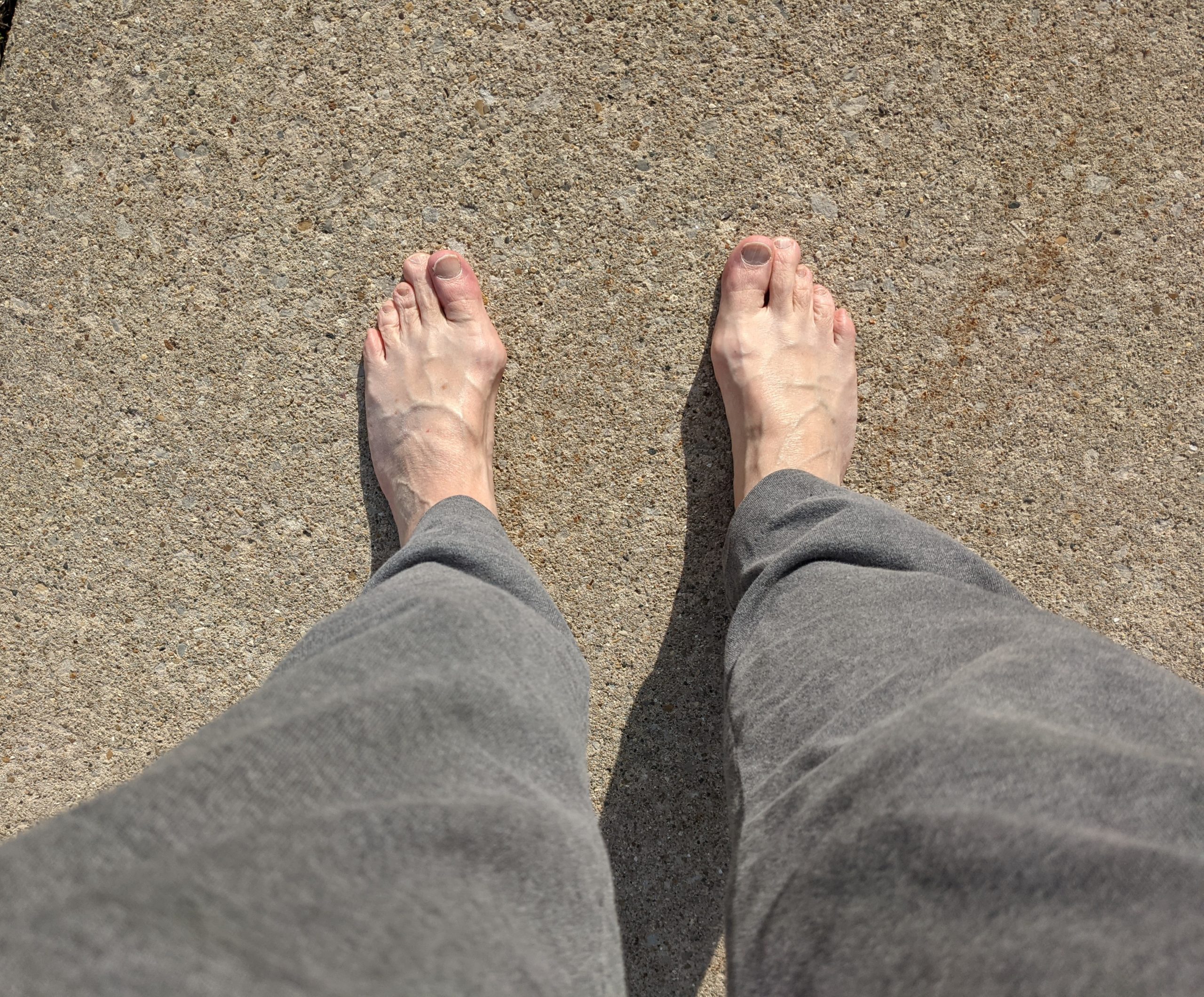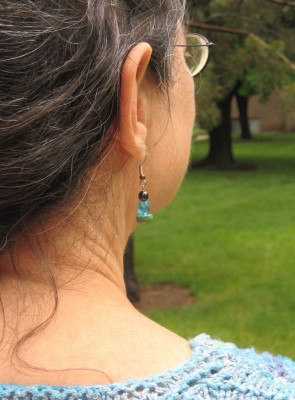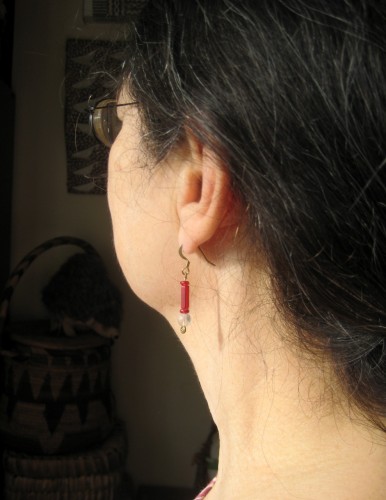Ekster la domo: mi kun nudaj piedoj. Fine printempo. #Esperanto #hajko #haiku Outside the house with bare feet. Finally spring.


Ekster la domo: mi kun nudaj piedoj. Fine printempo. #Esperanto #hajko #haiku Outside the house with bare feet. Finally spring.

I went for my first outdoor run of the year on Sunday. It was the first day that the paths were clear enough of ice and snow to make it possible.
Although the paths were mostly clear of ice and snow, there was a lot of melt water, flowing across the path in hundreds of rivulets. I found myself integrating into my run hundreds of small leaps, in a (partially successful) effort to keep my feet dry.
I was well aware of the leaps as I did them—I remember making a conscious effort to refrain from favoring one side over the other, trying to execute each leap with the most natural foot leading, based on my current point in my stride as I approached.
For some reason, all those leaps were not the first thing that came to mind the next day, when my calves were as sore as they have ever been. I was just sad at how much more out-of-shape I must be than I had realized, to be so crippled by a simple three-mile run. (They hurt a lot more than when I actually tore a calf muscle a couple years ago.) It was only late Tuesday, when I was heading to teach my taiji class, that I jumped over a similar stream of water in a parking lot—one calf screaming when I launched, the other screaming when I landed—that I realized that it was the leaping that had done such a number on me.
With that reassurance I felt much better, and by Wednesday my calves were feeling much better, which was good because Wednesday Jackie and I went on our first long walk of the year, part of the series of long walks we’re taking to prepare for the 33.5-mile Kal-Haven Trail walk that we’ve been meaning to take for a couple of years now. We’re quite determined that this will be the year.
For our first long walk we walked to taiji, attended our class, and then walked on to downtown Urbana and had lunch at Crane Alley (good beer). After lunch we walked back through campus. Having exceeded our planned distance (we wanted to do 10 miles and got in 11.5), we caught a bus at the south end of campus to go the rest of the way home. (The walk home from the south end of campus isn’t far, but there’s no good footpath. I think during the summer, when it’s possible to walk along the side of the farmer’s fields, it’ll be a fine walking route, but yesterday it would have been too wet and muddy.)
It was warm enough that I was able to expose my forearms to the sun!
My training plan, such as it is, covers just the long walks—we’ll include many shorter walks in our daily activity, and plenty of medium walks as well. But the long walk plan looks like this:
The main event is planned for roughly June 18th, but it will depend on the exact schedule of when we go to visit my dad and what the weather looks like those days. I figure we’ll be fit enough to do a very long walk of the planned distance any time after mid-May, so that gives us a month’s cushion to allow for any glitches.
I’m kind of excited about possible medium-length walks from our new house, here south of town. All of south campus is reasonably close, including, for example, the Arboretum with its cherry trees, which should be in bloom in about a month. It might make sense to walk there several times in early April, to keep up with the progress of the cherry blossoms, and take the opportunity for both haiku and photographs.
The most obvious way to walk (starting with the exact route from south Campus that I rejected yesterday) would be about 3 miles each way, the first half along the sides of country roads. As I say, it should be an entirely satisfactory route anytime the ground isn’t too wet.
Here’s the details for Sunday’s run:
And here’s the details for Wednesday’s walk:
I don’t really think of myself as a poet—the menu on my site, which includes categories for my fiction and my nonfiction, doesn’t even have a category for poetry. However, for many years now, I’ve been writing haiku in Esperanto.
It started specifically because of Esperanto. As a beginner with the language, I wanted something tractable. A haiku was small enough that, even if I had to look up every other word, I could put it together and keep it in my head long enough to compose and finish something.
It was also a shared activity with my brother, who was learning Esperanto as well, and similarly found haiku to be appropriately sized. Our haiku were often rather silly observations on the quotidian details of workaday life, and even more often shared jokes—puns based on elaborated misunderstandings of one another’s haiku, and the like.
A few years ago, Steve started taking his haiku more seriously. He read about the Japanese tradition of haiku. He started focusing on writing better haiku. He wrote a lot, and he shared them with other people who cared about haiku. He didn’t quit writing funny, trivial haiku, but he wrote more serious haiku. Haiku that tried to capture something universal through a keenly observed moment. Haiku that used the tools of the Japanese tradition to express something.
I found myself rather left behind. He encouraged me to make a similar study—he even lent me some books—but I didn’t find myself moved to deepen my understanding of haiku.
A few things happened since then. One was simply being more and more impressed with Steve’s haiku—feeling ever more keenly how left behind I was. Another was the publication, by a Japanese Esperantist we met on-line, of a book Kiel verki hajkojn en Esperanto (How to write haiku in Esperanto), which condensed a lot of the stuff Steve had been talking about and applied it specifically to Esperanto. Most recently, a local haiku poet (who also happens to be past president of the Haiku Society of America, former editor of Modern Haiku magazine, and current editor of the Modern Haiku Press) started a haiku study group that meets at the Champaign Public Library.
Participating in the study group, I took one of those little leaps that anyone who works in a creative endeavor takes from time to time. My haiku are perceptibly better.
And so I now have a published haiku. The same Lee Gurga who leads the study group also edits a weekly haiku feature in the News-Gazette, the local paper. He selected one of my haiku for today’s column. He elided the Esperanto original, so I thought I’d share that here:
Glataj folioj.
Senresta en mallumo…
kota genuo
Oh, and I should mention, this isn’t my first ever published haiku. One of my haiku was used as an example in Kiel verki hajkojn en Esperanto. Oh, and I’ve three times traded my haiku for earrings at the Haiku Earring Parties at WisCon.


Somebody came to my site after searching for information about the haiku earring parties at WisCon. That reminded me that I’d never gotten around to putting up a picture of Volcanoes on Vacation, the earrings I exchanged a haiku for at WisCon some years back.
So, here’s the picture.
I’ve lost my notes from that haiku earring party, so I don’t have the exact text of the haiku. I could probably recreate it, but the gist of it was one volcano lamenting the fact that they always vacation somewhere on the Pacific rim. I remember that the last line was, “Next year, Michigan!”
Jackie’s other earrings from haiku earring parties were documented here:
Elisem‘s haiku earring parties are always a highlight of WisCon for me. They’re a big part of the reason that I’m always sad when I have to miss a year.


I think I’ve mentioned it somewhere each time I’ve gotten Jackie a pair of earrings at one of Elisem‘s haiku earring parties, but The Sinister Leprechaun seems to be the only pair I’ve gotten since starting this particular iteration of my blog.
(Ah, it turns out that I wrote about Honor is Not Always Loud on my old LiveJournal, but don’t seem to have posted a picture until now. I don’t seem to find any mention of Volcanoes on Vacation. I should get a picture of them up as well.)
The haiku earring party is always one of the highlights of WisCon for me, which is only the smallest reason why this is wonderful news: On the Rewards of CALLING 911 RIGHT AWAY.
Learn the signs of a stroke. If anyone shows those signs—you or someone you’re with—call 911.

 The Sinister Leprechaun, originally uploaded by bradipo.
The Sinister Leprechaun, originally uploaded by bradipo.
Jackie and I attended the Haiku Earring Party at WisCon this evening.
In case you’re not familiar with it, here’s how it works: Elisem creates pairs of earrings. You pick out a pair you like and bring it to her. She gives the pair a title. You then write a haiku or senryu inspired by the title and the earrings, which you trade for the earrings.
At least, I tended to think of it as a swap—haiku for earrings. Jackie, it turns out, had a slightly different take on it. In her mind I was winning the earrings for her via a display of skill, like winning a stuffed animal by tossing rings at the county fair.
“The Sinister Leprechaun”
Find at rainbow’s end
Not expected pot of gold.
Green stones turning black.
Or, in Esperanto:
“La Minaca Irlanda Koboldo”
Ĉielarka fin’
Ne atendita oruj’
Verdŝton’ negirĝas